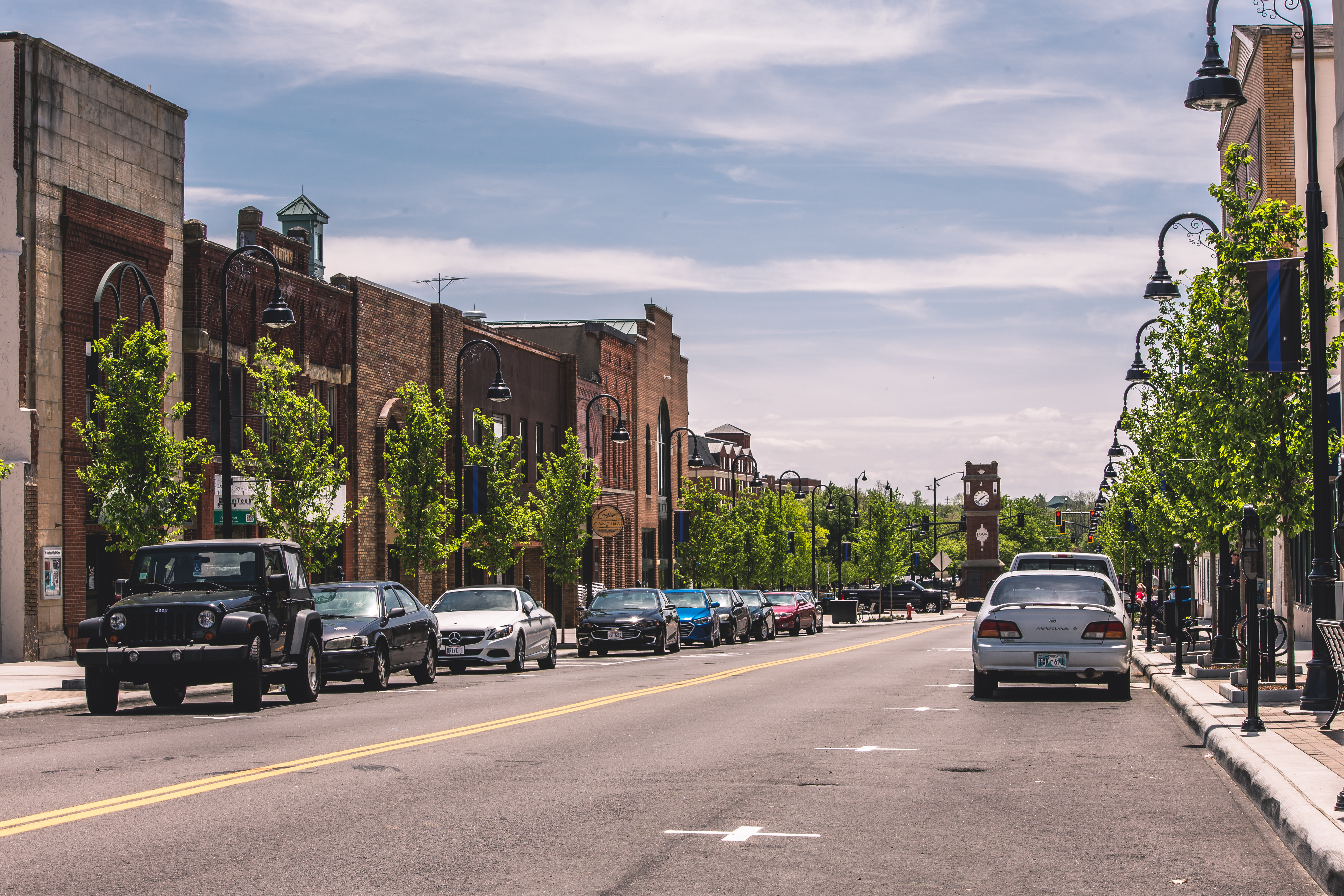|
Twinsburg
Twinsburg is a suburban city in Summit County, Ohio, United States, located midway between Akron, Ohio, Akron and Cleveland. The population was 19,248 as of the 2020 census. It is part of the Akron metropolitan area. History The first person to settle Millsville was sixteen year-old Ethan Alling, who in 1817 moved to Township Five in the tenth range of the Connecticut Land Company. The next year, identical twins Moses and Aaron Wilcox began selling discounted parcels of land and announced they would donate 6 acres of land to the community and donate money to fund a school should the locals rename the settlement "Twinsburg." The Twinsburg Post Office was established in 1825 and was run by Ethan Alling. In addition to his duties as postmaster, Alling later would become the town's "stagecoach operator, merchant and hotel proprietor". The Twinsburg Historical Society was founded in 1963. They run a museum which houses historical documents and artefacts used by early settlers. The Mai ... [...More Info...] [...Related Items...] OR: [Wikipedia] [Google] [Baidu] |
Akron Metropolitan Area
The Akron, OH Metropolitan Statistical Area, sometimes referred to as Greater Akron, is defined by the United States Office of Management and Budget as an area consisting of two counties, Summit County, Ohio, Summit and Portage County, Ohio, Portage, in Northeast Ohio and anchored by the city of Akron, Ohio, Akron. As of the United States Census, 2020, 2020 census, the MSA had a population of 702,219. The Akron MSA is also part of the larger Northeast Ohio, Cleveland–Akron–Canton, OH Combined Statistical Area, which has a population of 3,633,962 people as of the 2020 census, the largest Ohio census statistical areas, metropolitan area in Ohio. Historically, Greater Akron was known as the center of the United States' tire and rubber industry throughout the 20th century, and today one major tire company (Goodyear Tire and Rubber Company, Goodyear Tire and Rubber) still is based there. More recently, the area has become a center of polymer science research and manufacturing for ... [...More Info...] [...Related Items...] OR: [Wikipedia] [Google] [Baidu] |
Summit County, Ohio
Summit County is an urban county located in the northeast region of the U.S. state of Ohio. As of the 2020 census, the population was 540,428, making it the fourth-most populous county in Ohio. Its county seat and largest city is Akron. The county was formed on March 3, 1840, from portions of Medina, Portage and Stark counties. It was named Summit County because the highest elevation on the Ohio and Erie Canal is in the county. Summit County is part of the Akron, OH Metropolitan Statistical Area, which is also included in the Cleveland-Akron-Canton, OH Combined Statistical Area. Geography According to the United States Census Bureau, the county has a total area of , of which is land and (1.7%) is water. The largest portion of Cuyahoga Valley National Park is in the northern part of the county. The southern border of the former Connecticut Western Reserve passes through the southern part of the county, leading to jogs in the east and west borders of the county. Major hi ... [...More Info...] [...Related Items...] OR: [Wikipedia] [Google] [Baidu] |
City
A city is a human settlement of a substantial size. The term "city" has different meanings around the world and in some places the settlement can be very small. Even where the term is limited to larger settlements, there is no universally agreed definition of the lower boundary for their size. In a narrower sense, a city can be defined as a permanent and Urban density, densely populated place with administratively defined boundaries whose members work primarily on non-agricultural tasks. Cities generally have extensive systems for housing, transportation, sanitation, Public utilities, utilities, land use, Manufacturing, production of goods, and communication. Their density facilitates interaction between people, government organisations, government organizations, and businesses, sometimes benefiting different parties in the process, such as improving the efficiency of goods and service distribution. Historically, city dwellers have been a small proportion of humanity overall, bu ... [...More Info...] [...Related Items...] OR: [Wikipedia] [Google] [Baidu] |
Asian (U
Asian may refer to: * Items from or related to the continent of Asia: ** Asian people, people in or descending from Asia ** Asian culture, the culture of the people from Asia ** Asian cuisine, food based on the style of food of the people from Asia ** Asian (cat), a cat breed similar to the Burmese but in a range of different coat colors and patterns * Asii (also Asiani), a historic Central Asian ethnic group mentioned in Roman-era writings * Asian option, a type of option contract in finance * Asyan, a village in Iran See also * * * East Asia * South Asia * Southeast Asia Southeast Asia is the geographical United Nations geoscheme for Asia#South-eastern Asia, southeastern region of Asia, consisting of the regions that are situated south of China, east of the Indian subcontinent, and northwest of the Mainland Au ... * Asiatic (other) {{disambiguation ... [...More Info...] [...Related Items...] OR: [Wikipedia] [Google] [Baidu] |
Native American (U
Native Americans or Native American usually refers to Native Americans in the United States Native Americans (also called American Indians, First Americans, or Indigenous Americans) are the Indigenous peoples of the Americas, Indigenous peoples of the United States, particularly of the Contiguous United States, lower 48 states and A .... Related terms and peoples include: Ethnic groups * Indigenous peoples of the Americas, the pre-Columbian peoples of North, South, and Central America and their descendants * Indigenous peoples in Canada ** First Nations in Canada, Canadian Indigenous peoples who are neither Inuit nor Métis ** Inuit, Indigenous peoples inhabiting the Arctic and subarctic regions of Greenland, Labrador, Quebec, Nunavut, the Northwest Territories, and Alaska. ** Métis in Canada, specific cultural communities who trace their descent to early communities consisting of both First Nations people and European settlers * Indigenous peoples of Costa Rica * Indi ... [...More Info...] [...Related Items...] OR: [Wikipedia] [Google] [Baidu] |
African American (U
African Americans, also known as Black Americans and formerly also called Afro-Americans, are an Race and ethnicity in the United States, American racial and ethnic group that consists of Americans who have total or partial ancestry from any of the Black people, Black racial groups of Africa. African Americans constitute the second largest ethno-racial group in the U.S. after White Americans. The term "African American" generally denotes descendants of Slavery in the United States, Africans enslaved in the United States. In 2023, an estimated 48.3 million people self-identified as Black, making up 14.4% of the country’s population. This marks a 33% increase since 2000, when there were 36.2 million Black people living in the U.S. African-American history began in the 16th century, with Africans being sold to Atlantic slave trade, European slave traders and Middle Passage, transported across the Atlantic to Slavery in the colonial history of the United States, the Western He ... [...More Info...] [...Related Items...] OR: [Wikipedia] [Google] [Baidu] |
White (U
White is the lightest color and is achromatic (having no chroma). It is the color of objects such as snow, chalk, and milk, and is the opposite of black. White objects fully (or almost fully) reflect and scatter all the visible wavelengths of light. White on television and computer screens is created by a mixture of red, blue, and green light. The color white can be given with white pigments, especially titanium dioxide. In ancient Egypt and ancient Rome, priestesses wore white as a symbol of purity, and Romans wore white togas as symbols of citizenship. In the Middle Ages and Renaissance a white unicorn symbolized chastity, and a white lamb sacrifice and purity. It was the royal color of the kings of France as well as the flag of monarchist France from 1815 to 1830, and of the monarchist movement that opposed the Bolsheviks during the Russian Civil War (1917–1922). Greek temples and Roman temples were faced with white marble, and beginning in the 18th c ... [...More Info...] [...Related Items...] OR: [Wikipedia] [Google] [Baidu] |
Population Density
Population density (in agriculture: Standing stock (other), standing stock or plant density) is a measurement of population per unit land area. It is mostly applied to humans, but sometimes to other living organisms too. It is a key geographical term.Matt RosenberPopulation Density Geography.about.com. March 2, 2011. Retrieved on December 10, 2011. Biological population densities Population density is population divided by total land area, sometimes including seas and oceans, as appropriate. Low densities may cause an extinction vortex and further reduce fertility. This is called the Allee effect after the scientist who identified it. Examples of the causes of reduced fertility in low population densities are: * Increased problems with locating sexual mates * Increased inbreeding Human densities Population density is the number of people per unit of area, usually transcribed as "per square kilometre" or square mile, and which may include or exclude, for example, ar ... [...More Info...] [...Related Items...] OR: [Wikipedia] [Google] [Baidu] |
Census
A census (from Latin ''censere'', 'to assess') is the procedure of systematically acquiring, recording, and calculating population information about the members of a given Statistical population, population, usually displayed in the form of statistics. This term is used mostly in connection with Population and housing censuses by country, national population and housing censuses; other common censuses include Census of agriculture, censuses of agriculture, traditional culture, business, supplies, and traffic censuses. The United Nations (UN) defines the essential features of population and housing censuses as "individual enumeration, universality within a defined territory, simultaneity and defined periodicity", and recommends that population censuses be taken at least every ten years. UN recommendations also cover census topics to be collected, official definitions, classifications, and other useful information to coordinate international practices. The United Nations, UN's Food ... [...More Info...] [...Related Items...] OR: [Wikipedia] [Google] [Baidu] |
Square Mile
The square mile (abbreviated as sq mi and sometimes as mi2)Rowlett, Russ (September 1, 2004) University of North Carolina at Chapel Hill. Retrieved February 22, 2012. is an imperial and US unit of measure for area. One square mile is equal to the area of a square with each side measuring a length of one mile. Equivalents One square mile is equal to: *4,014,489,600 square inches * * * * One square mile is also equivalent to: * * * Similarly named units Miles square Square miles should not be confused with miles square, a square region with each side having a length of the value given. For example, a region which is 20 miles square ( × ) has an area of ; a rectangle of measuring × also has an area of , but is not 20 miles square. Section In the United States Public Land Survey System The Public Land Survey System (PLSS) is the surveying method developed and used in the United States to plat, or divide, real property for sale and settling. Also known as ... [...More Info...] [...Related Items...] OR: [Wikipedia] [Google] [Baidu] |
Km²
The square kilometre (square kilometer in American spelling; symbol: km2) is a multiple of the square metre, the SI unit of area or surface area. In the SI unit of area (m2), 1 km2 is equal to 1M(m2). 1 km2 is equal to: * 1,000,000 square metres (m2) * 100 hectares (ha) It is also approximately equal to: * 0.3861 square miles * 247.1 acres Conversely: *1 m2 = 0.000001 (10−6) km2 *1 hectare = 0.01 (10−2) km2 *1 square mile = *1 acre = about The symbol "km2" means (km)2, square kilometre or kilometre squared and not k(m2), kilo–square metre. For example, 3 km2 is equal to = 3,000,000 m2, not 3,000 m2. Examples of areas of 1 square kilometre Topographical map grids Topographical map grids are worked out in metres, with the grid lines being 1,000 metres apart. * 1:100,000 maps are divided into squares representing 1 km2, each square on the map being one square centimetre in area and representing 1 km2 on the surface of the Earth. ... [...More Info...] [...Related Items...] OR: [Wikipedia] [Google] [Baidu] |








